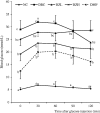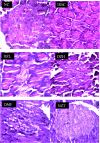Effects of butanol fraction of Ziziphus mucronata root ethanol extract on glucose homeostasis, serum insulin and other diabetes-related parameters in a murine model for type 2 diabetes
- PMID: 27937039
- PMCID: PMC6130741
- DOI: 10.1080/13880209.2016.1242632
Effects of butanol fraction of Ziziphus mucronata root ethanol extract on glucose homeostasis, serum insulin and other diabetes-related parameters in a murine model for type 2 diabetes
Abstract
Context: Ziziphus mucronata Willd (Rhamnaceae) is currently used in Nigerian traditional treatment of diabetes mellitus. However, detailed information on the antidiabetic potential of the plant parts is presently unknown.
Objectives: The present study investigated the antidiabetic effects of the butanol fraction of Z. mucronata root (ZMBF) in a type 2 diabetes (T2D) model of rats.
Materials and methods: T2D was induced in rats by feeding a 10% fructose solution ad libitum for two weeks followed by an intraperitoneal injection of streptozotocin (40 mg/kg bw) and the animals were orally treated with ZMBF 150 or 300 mg/kg bw for five days a week for four weeks. Food and fluid intake, body weight changes and blood glucose levels were monitored during the experiment while other blood and organ specific diabetes-associated parameters were measured at the end of the experiment.
Results: After four-week treatment, significantly (p < 0.05) lower blood glucose (19.24 vs 28.96 mmol/L), improved glucose tolerance ability (21.26 vs 28.56 mmol/L), higher serum insulin (131.37 vs 64.20 pmol/L) and liver glycogen (2.40 vs 1.54 mg/g tissue) were observed in the 300 mg/kg ZMBF ingested group compared with the diabetic control group. However, food and fluid intake, body weight gain, HOMA-β, HOMA-IR, serum fructosamine level, hepatic and renal function tests were not significantly (p > 0.05) affected by the treatment of ZMBF.
Conclusion: Results of this study suggest that ZMBF treatment, at 300 mg/kg bw, possess antidiabetic activity, but could not ameliorate some diabetes-related parameters in type 2 diabetic rats.
Keywords: Buffalo thorn; blood glucose; glucose tolerance; insulin resistance; liver glycogen; β-cell function.
Figures





Similar articles
-
Butanol fraction of Khaya senegalensis root modulates β-cell function and ameliorates diabetes-related biochemical parameters in a type 2 diabetes rat model.J Ethnopharmacol. 2014 Jul 3;154(3):832-8. doi: 10.1016/j.jep.2014.05.011. Epub 2014 May 17. J Ethnopharmacol. 2014. PMID: 24846204
-
Butanol fraction of Parkia biglobosa (Jacq.) G. Don leaves enhance pancreatic β-cell functions, stimulates insulin secretion and ameliorates other type 2 diabetes-associated complications in rats.J Ethnopharmacol. 2016 May 13;183:103-111. doi: 10.1016/j.jep.2016.02.018. Epub 2016 Feb 18. J Ethnopharmacol. 2016. PMID: 26911526
-
Anti-diabetic effect of Xylopia aethiopica (Dunal) A. Rich. (Annonaceae) fruit acetone fraction in a type 2 diabetes model of rats.J Ethnopharmacol. 2016 Mar 2;180:131-9. doi: 10.1016/j.jep.2016.01.009. Epub 2016 Jan 12. J Ethnopharmacol. 2016. PMID: 26795545
-
The effect of Astragalus as an adjuvant treatment in type 2 diabetes mellitus: A (preliminary) meta-analysis.J Ethnopharmacol. 2016 Sep 15;191:206-215. doi: 10.1016/j.jep.2016.05.062. Epub 2016 Jun 3. J Ethnopharmacol. 2016. PMID: 27269392 Review.
-
The application of metabolomics in investigating anti-diabetic activity of medicinal plants.Biomed Pharmacother. 2020 Aug;128:110263. doi: 10.1016/j.biopha.2020.110263. Epub 2020 May 22. Biomed Pharmacother. 2020. PMID: 32450525 Review.
Cited by
-
Anti-hyperglycemic and ameliorative effect of concentrated hot water-infusion of Phragmanthera incana leaves on type 2 diabetes and indices of complications in diabetic rats.J Diabetes Metab Disord. 2019 Nov 14;18(2):495-503. doi: 10.1007/s40200-019-00456-5. eCollection 2019 Dec. J Diabetes Metab Disord. 2019. PMID: 31890675 Free PMC article.
-
Potential antidiabetic phytochemicals in plant roots: a review of in vivo studies.J Diabetes Metab Disord. 2021 Jul 12;20(2):1837-1854. doi: 10.1007/s40200-021-00853-9. eCollection 2021 Dec. J Diabetes Metab Disord. 2021. PMID: 34900828 Free PMC article. Review.
-
Ziziphus mucronata Willd. (Rhamnaceae): it's botany, toxicity, phytochemistry and pharmacological activities.Heliyon. 2020 Apr 19;6(4):e03708. doi: 10.1016/j.heliyon.2020.e03708. eCollection 2020 Apr. Heliyon. 2020. PMID: 32322712 Free PMC article.
-
Antidiabetic Potential of Medicinal Plants and Their Active Components.Biomolecules. 2019 Sep 30;9(10):551. doi: 10.3390/biom9100551. Biomolecules. 2019. PMID: 31575072 Free PMC article. Review.
-
Ethnomedicinal Knowledge of Plants Used in Nonconventional Medicine in the Management of Diabetes Mellitus in Kinshasa (Democratic Republic of the Congo).Evid Based Complement Alternat Med. 2023 Sep 20;2023:4621883. doi: 10.1155/2023/4621883. eCollection 2023. Evid Based Complement Alternat Med. 2023. PMID: 37771953 Free PMC article.
References
-
- Adewusi EA, Steenkamp V.. 2011. In vitro screening for acetylcholinesterase inhibition and antioxidant activity of medicinal plants from Southern Africa. Asian Pac J Trop Med. 4:829–835. - PubMed
-
- American Diabetes Association. 2007. Report of the expert committee on the diagnosis and classification of diabetes mellitus. Diabetes Care. 30:S42–S47. - PubMed
-
- Boudjelal A, Henchiri C, Siracusa L, Sari M, Ruberto G.. 2012. . Compositional analysis and in vivo anti-diabetic activity of wild Algerian Marrubium vulgare L. infusion. Fitoterapia. 83:286–292. - PubMed
-
- Etuk EU, Bello SO, Isezuo SA, Mohammed BJ.. 2010. Ethnobotanical survey of medicinal plants used for the treatment of diabetes mellitus in the north western region of Nigeria. Asian J Exp Biol Sci. 1:55–59.
-
- Farook MS, Atlee WC, Karimulla S, Davey MS.. 2011. Assessment of antidiabetic potential of Caesalpinia digyna Rottler root extract in streptozotocin induced diabetic rats. Int J Pharm Sci Res. 2:675–684.
MeSH terms
Substances
LinkOut - more resources
Full Text Sources
Other Literature Sources
Medical
